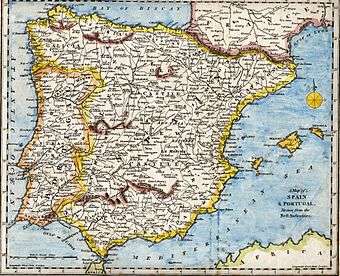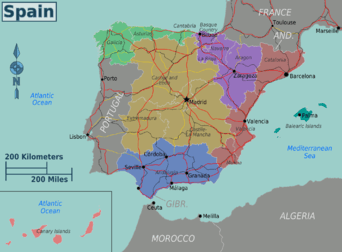Loa (Spanish play)
A loa is a short theatrical piece, a prologue, written to introduce comedias and autos sacramentales in the Spanish Golden Age (Siglo de Oro) and later in Latin America through Spanish colonization. This Spanish prologue uses praise and laudatory language to introduce a full-length play. [1] The purpose is to initially capture the interest of the audience and to set the mood for the rest of the performance.[2]
Purpose


During 16th century public presentations of comedias in Madrid, Spain, performances would begin at 2pm. Audiences would arrive early and vendors would sell foods. Soon these audiences would become impatient and start loudly hissing, whistling and shouting. One hour before the performance, musicians came onto the stage to sing a ballad (seguidilla) and immediately after an actor or member of the company came on stage to "echar la loa" or "throw out praise" by reciting a loa.[2] Most comedia playwrights (autors) also wrote loas asking the audience for silence in order to enjoy the afternoon of theatre.[3]
Loas sometimes did but often didn't have any relation to the full-length play being presented. Loas appeared in two distinct forms. The first was in a monologue form and the second was in the form of a short dramatic scene. [2]
In order to gain the audiences attention and appreciation, one could commend the story or the author; reprimand negative critics or thank those that were positive and the audiences present that day; discuss and argue about the play that was to be presented. The third method was not often used because audiences would be told the outcome of the play before they were able to hear it. In turn, the Spanish loa was created as a mixture of all of these methods of achieving audience appreciation before the full-length play began.[2]
History of the Loa
Bartolomé de Torres Naharro, Spanish dramatist, is the earliest known writer of Spanish comedias and of the introductory monologue. It is important to note, in order to be considered a Spanish comedia, a Spanish play must only be in verse and in three acts (jornadas). Content can be comedic or tragic. In Naharro's volume of plays, Propaladia (published in 1517 in Naples), he uses what is called an introito as a prologue spoken by a comic shepherd. Furthermore, traces of the beginnings of the introitos are seen in medieval mystery plays of the 15th Century in Spain in the eclogues, short poems, (églogas) of Juan del Encina using a similar comic shepherd character within a Christmas play. Introitos and argumentos, another similar form of prologue used by Naharro, are both early forms of the loa that provide a summary or explanation of the comedia that follows it. [2][4]
Loas in Spain: Comedias

Lope de Vega
Lope de Vega is said to have "perfected" the Spanish comedia.[2] The drama of the Spanish Golden Age is often characterized by his work so that pre- Lope de Vega drama of the 16th century is said to have used the introito which was soon replaced by the loa.[4] His loas tend to have no connection to the play that follows and are characterized by their playful, humorous, trivial and always ending with a positive appeal to the audience for the rest of the performance. Vega's loas vary from 100 to 400 lines and he is thought to have written a lot of them but nearly all have been lost.[2]
Agustín de Rojas Villandrando

Agustín de Rojas Villandrano published and became well known for his loas in Entertaining Journey (El viaje entrentenido). His loas included monologues and short sketch scenes that the whole company of actors participated in. His most famous loa is the Loa en Alabanza de la Comedia.
A translation:
Who with these is not aquainted?
Who, whom fame of them not reached?
Who in wonderment beholds not
Their rare wit and sounding phrases?
And allowing that it is true,
Is it not strange that I should venture
In their name now to entreat you
That, because of the great rev'rence
Which to their rare works is owning,
While their plays are prepresented,
You may pardon the shortcomings
Of the players who perform them.[1]
- ^ Cite error: The named reference
:03was invoked but never defined (see the help page).
The subjects of praise in his loas varied from praising a city, the company of actors performing, thieves, the day Tuesday, teeth and pigs.[2]
A translation of the end of the swine praising loa:
And if long have been my praises
Of an animal so lovely,
May he who should be one pardon
Me, and therefore not feel shameful.
Published in 1604, Rojas' novel, El viaje entrentendio depicts the life of 16th century Spanish actors. It starts with characters leaving the city Seville. Rojas writes a loa that praises Seville which is meant to be spoken to the people of that city. [5] In the same body of work, Rojas Villandrando also praises Lope de Rueda for his writing of the Spanish drama and of the dramatic prologue. [4]
Lope de Rueda
Lope de Rueda wrote and spoke himself, introductory notes called Introito que hace el Autor. He also wrote introitos or argumentos for his later plays, Colloquio de Camila and Colloquio de Timbria.[2]
Quiñones de Benavente
Quiñones de Benavente similarly wrote loas that were used to preface any comedia mostly unrelated to the loa.[2]
Loas in Spain: Autos Sacramentales
Calderón de la Barca
Calderón wrote loas specifically for plays that had been previously written and for his own plays that were autos sacramentales. His loas were used specifically to understand the particular play that followed. An example is in his loa to Los tres mayores Prodigos.[2]
Loas in Latin America
.jpg)
Because of beginning monologue form of the Loa, it is also considered the origins of monologue in Latin America. Monologues appeared in laudatory prologues or introductions as loas in the plays of Hispanic America and are called elogios dramaticos in Brazil.[6]
Fernán González de Eslava
Mexican playwright, González de Eslava (1534-1601) used loas in eight of his plays. The loas are all short monologues that praise a saint, the sacrament or a Viceroy, provide a synopsis and end with a plea for silence.[1]
Sor Juana Inés de la Cruz
Sor Juana is said to have written hundreds of loas in Peru and New Spain but only eighteen remain. Throughout the seventeenth century loas gained popularity because of the opportunity to praise and flatter the governing Viceroys, their courts and the monarchs of Spain. Sor Juana wrote loas both secular, to praise the royal courts and sacred, to promote religious Christian practices for autos sacramentales like those by Calderón de la Barca. Most notable of these sacred loas is Loa para el Auto de el Divino Narciso.[7]
References
- 1 2 Pasquariello, Anthony M. (1970). "The Evolution of the Loa in Spanish America". Latin American Theatre Review. 3, no. 2.
- 1 2 3 4 5 6 7 8 9 10 11 Rennert, Hugo Albert (1963). The Spanish Stage in the Time of Lope de Vega. New York: Dover Publications, Inc. pp. 274–286.
- ↑ Delgado, Maria M.; Gies, David T. (2012). A History of Theatre in Spain. United Kingdom: Cambridge University Press. p. 54. ISBN 978-0521117692.
- 1 2 3 Meredith, Joseph A. (1928). Introito and Loa in the Spanish Drama of the Sixteenth Century. Philadelphia: University of Pennsylvania.
- ↑ Shergold, N.D. (1967). A History of the Spanish Stage from Medieval Times until the end of the Seventeenth Century. Great Britain: Oxford University Press. p. 508.
- ↑ Rhoades, Duane (1985). The Independent Monologue in Latin American Theater. Greenwood Publishing Group. ISBN 978-0313250804.
- ↑ Pasquariello, Anthony M. (1970). "The Evolution of the Loa in Spanish America". Latin American Theatre Review. 3.